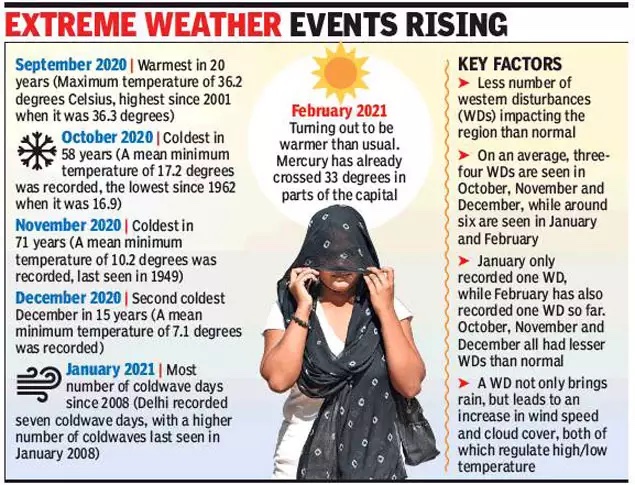Extreme weather events: India
(→Extreme weather events in India during the winter of 2020-21) |
|||
| Line 23: | Line 23: | ||
==Extreme weather events in India during the winter of 2020-21== | ==Extreme weather events in India during the winter of 2020-21== | ||
[[File: Extreme weather events in India during the winter of 2020-21 A.jpg| Extreme weather events in India during the winter of 2020-21 <br/> Graphic courtesy: [15-year high for Feb day: Extreme weather is here - The Times Of India - Delhi, 2/25/2021 (timesgroup.com) ''The Times of India'']|frame|500px]] | [[File: Extreme weather events in India during the winter of 2020-21 A.jpg| Extreme weather events in India during the winter of 2020-21 <br/> Graphic courtesy: [15-year high for Feb day: Extreme weather is here - The Times Of India - Delhi, 2/25/2021 (timesgroup.com) ''The Times of India'']|frame|500px]] | ||
| − | |||
15-year high for Feb day: Extreme weather is here | 15-year high for Feb day: Extreme weather is here | ||
| Line 50: | Line 49: | ||
[[Category:India|E | [[Category:India|E | ||
EXTREME WEATHER EVENTS: INDIA]] | EXTREME WEATHER EVENTS: INDIA]] | ||
| − | [[Category:Pages with broken file links|EXTREME WEATHER EVENTS: INDIA]] | + | |
| + | [[Category:Climate|E EXTREME WEATHER EVENTS: INDIA | ||
| + | EXTREME WEATHER EVENTS: INDIA]] | ||
| + | [[Category:India|E EXTREME WEATHER EVENTS: INDIA | ||
| + | EXTREME WEATHER EVENTS: INDIA]] | ||
| + | [[Category:Pages with broken file links|EXTREME WEATHER EVENTS: INDIA | ||
| + | EXTREME WEATHER EVENTS: INDIA]] | ||
Revision as of 14:53, 26 September 2021
This is a collection of articles archived for the excellence of their content. |
Extreme minimum and maximum temperature; precipitation
1935-2019
Jasjeev Gandhiok, March 16, 2020: The Times of India

From: Jasjeev Gandhiok, March 16, 2020: The Times of India
“Extreme minimum and maximum temperature events appear to be increasing in Delhi. In December 2006, Delhi had the lowest temperature since 1935 (0.2°C). In June 2007, Delhi witnessed a maximum of 44.9°C. While these extreme temperatures cannot be directly linked to climate change, variability in weather patterns and possibility of exacerbation of extreme events due to climate change are major challenges,” stated a government document.
It added that there had been several months when temperature and precipitation were greater than standard deviation from the mean. “The hottest summer was in 1944, the coldest winter in 1935 and the wettest monsoon in 1958. However, recent years have seen similar extremes in temperature in 1978, 1988 and 1996 and precipitation in 1994, 1995, and 2003,” it added.
Extreme weather events in India during the winter of 2020-21
15-year high for Feb day: Extreme weather is here Jasjeev Gandhiok & Priyangi Agarwal TNN
Extreme weather events are becoming more common than you would believe with the past six months not only recording a high variation in the daily maximum and minimum temperatures but within and between months too. Having recorded its warmest September in nearly two decades, the city experienced temperatures below the mean minimum in the three months that followed.
North India most polluted this winter
North India was the most polluted region in the nation this winter with NCR cities recording higher levels of pollutants, finds a study. P 5
Why weather blew hot and cold this season
January saw the maximum number of ‘cold wave’ days in the past 13 years but February is turning out to be much warmer than normal.
Experts say the lack of western disturbances this winter season has played a key role in this unusual weather pattern. Western disturbances ‘regulate’ the temperature and ensure that both the maximum and minimum temperatures do not touch extremes.
According to Indian Meteorological Department, last September was the warmest in nearly two decades with a mean maximum temperature of 36.2 degrees. The last time it was higher was in September of 2001, when it was 36.3 degrees. October, however, was the opposite, recording a mean minimum temperature of just 17.2 degrees, the lowest in 58 years. November broke an even older record, with a mean minimum temperature of 10.2 degrees, last seen in 1949, while December was the second coldest in the past 15 years, shows IMD data. January continued to be chilly, recording the highest number of cold wave days in the month – seven – since 2008. February has again swung to the other extreme.
Kuldeep Srivastava, a scientist at IMD and head of Regional Weather Forecasting Centre (RWFC) in Delhi, says while the months of October, November and December see on an average around three to four western disturbances, there are usually five to six in January and February each. “The lack of western disturbance activity is the primary reason here. We’ve seen only one in January and one so far in February. These were fewer in October, November and December too,” said Srivastava, who says lack of western disturbance activity leads to clear skies, which not only causes high day-time temperatures but extremely low night-time temperatures. “Clouds trap heat during the day, which means nights are a little warmer too, but with no clouds to trap the heat, we saw night time temperatures fall to as low as 1.1 degree Celsius this winter. Similarly, direct sunlight is falling during the day,” said Srivastava.
He, however, added a note of caution, saying that a longterm trend will need to be established and analysed before we could call it an impact of climate change.
